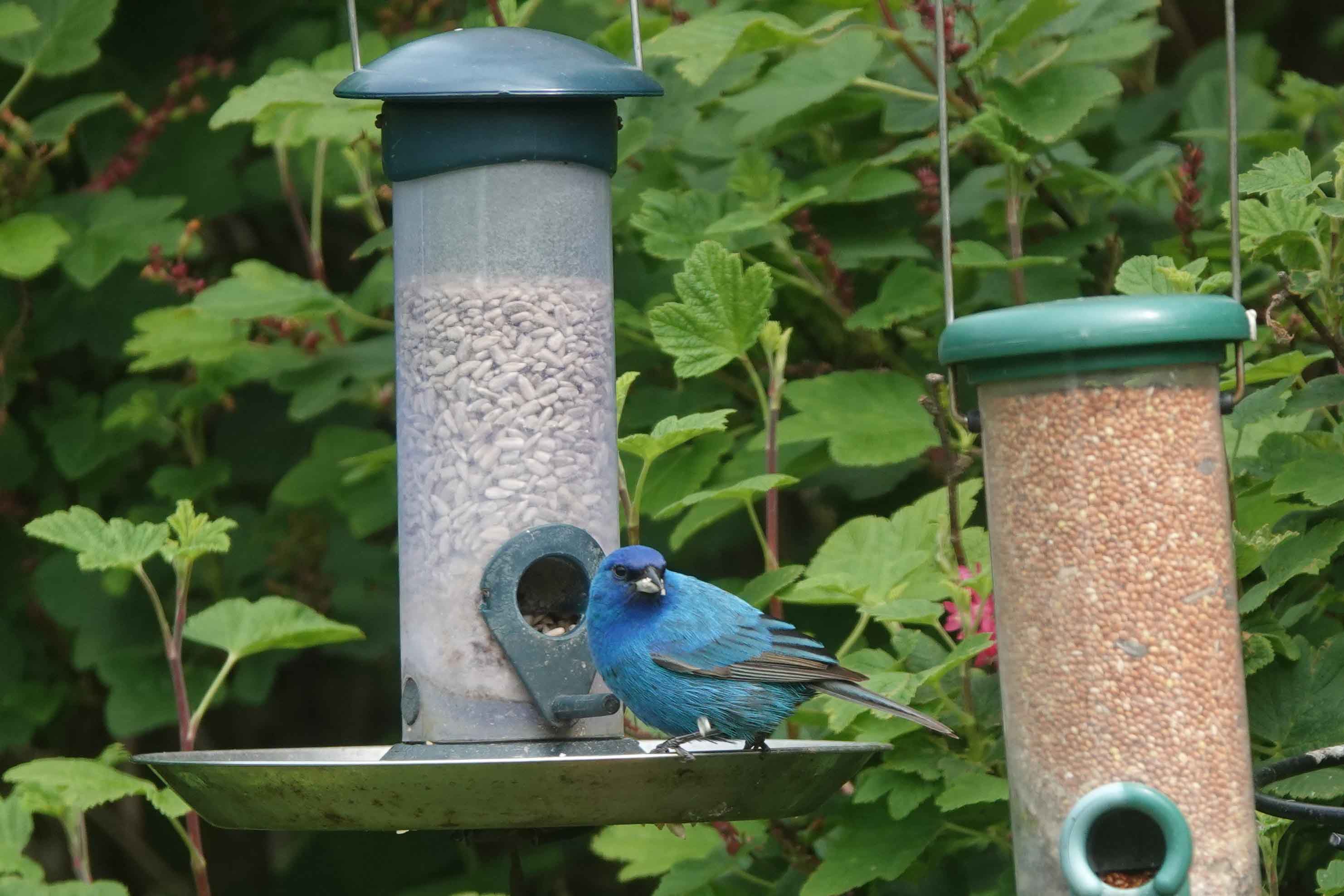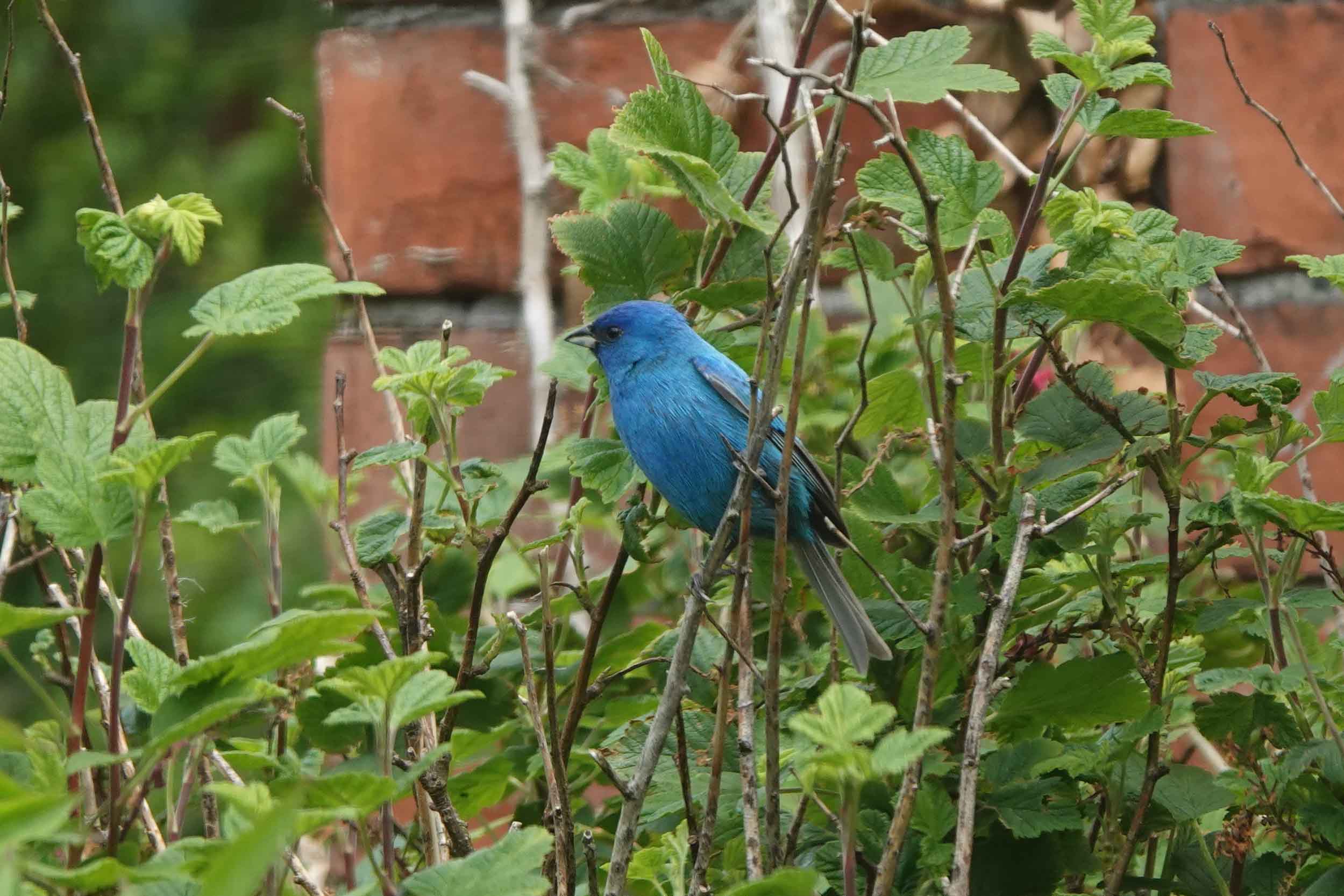It was around 12.25 pm on Saturday 18 May and I was at home in Whitburn, finishing off writing up a few bird notes from a visit to Norfolk in the preceding few days. I looked up from my notes on the kitchen table and was astonished to see a bright blue passerine jockeying for position with the regular Tree Sparrows at the feeders in our back garden. My heart skipped several beats.
Looking at it through binoculars for the first time, it immediately reminded me of the Indigo Buntings I'd seen in Florida years ago. Could it be one – or was there some other explanation? Another blue passerine, perhaps an escape that I'd never heard of?
Fumbling with my camera, I managed to take a few record shots. My wife Janette did the same with her phone. I then reached for the The Sibley Guide to Birds and had a reassuring glance to confirm that it was indeed a male Indigo Bunting.

Peter quickly took photos of the bright blue bird in his garden, having immediately thought of Indigo Bunting when he saw it (Peter Bell).
I fired a couple of messages off, first of all tentatively to a group of my birding friends, then with more conviction on the Durham Bird Club Rare and Scarce WhatsApp Group. Rare indeed! Seconds after that, the news was out on BirdGuides. Not long after, the first local birders, Barry Stidolph and Ian Mills, closely followed by Andrew Kinghorn, had seen it and confirmed my ID, which was a relief.
It wasn't long before others started to arrive and the kitchen was full ... then the back bedroom, and then the study! Our back garden at 10 Lizard Lane is completely surrounded, so the only way of viewing it is from the house. Fortunately, the Indigo Bunting continued to perform intermittently throughout the afternoon, but began to show more readily in the adjacent garden of our neighbours, Ian and Susan on Marsden Grove – they also have feeders – and in other surrounding trees. It even perched on a TV aerial, and also sang, although I was in the house and unable to hear it.

Janette and Peter welcomed birders into their house as a mass twitch ensued (Matthew Naylor).
I initially thought the bird was an adult because it was so bright, but more expert help, combined with better views and of course photos, indicated that it was a first-summer, having some unmoulted brownish flight feathers. This, together with the fact that it was unringed, will do its credentials no harm at all.
It showed on and off in our garden until roughly 4 pm, but there were later sightings in Marsden Grove until around 7.20 pm. Some 100 people must have come through the house and there were no doubt far more along Marsden Grove who I never even saw.
However, the early morning gathering the following day [19 May] were to be disappointed as there was no sign of the bunting – until it reappeared in Marsden Grove on our neighbour's feeder at 12.45 pm. As of today [Monday 20 May], it is still around.
This is, if accepted as a wild bird, only the fourth UK record, and the first on the mainland. Ironically it isn't even a UK tick for me – I saw the first-winter male on Ramsey Island in 1996. This one is a lot prettier, though!

If accepted, the Whitburn Indigo Bunting will be the fourth for Britain. There are a further two Category E records (Frank Golding).
Visitors from as far as Kent and Norfolk caught up with it on the first day and many also commented on our Tree Sparrows. They are this garden's real success story. We feed them red millet and had a winter peak of 55 in our small back garden. Numbers are down to single figures now, with just local breeding birds remaining, but they are even nesting under the eaves of the adjacent house on Marsden Grove. They first appeared in our neighbour's garden in 2010 and numbers have been increasing steadily since. The bunting, incidentally, is only interested in sunflower hearts.
I'd like to extend a special thanks to Ian Mills, Andrew Kinghorn and Sam Viles for their advice on ageing the bird and also in helping to organise the subsequent twitch. Thanks also to everyone else for being so kind and generous. We organised a collection, to be shared equally between Durham Bird Club and Durham Wildlife Trust. This raised £367 on the first afternoon.
This small garden has growing pedigree, but the Wryneck in September 2022 and a couple of Yellow-browed Warblers before that – not to mention a few decent fly-overs – pale into insignificance now! We've lived here for almost 27 years and I doubt we'll ever experience another day like 18 May 2024.

More than 100 birders visited Peter's house on the first afternoon of the Indigo Bunting's stay (Peter Bell).


